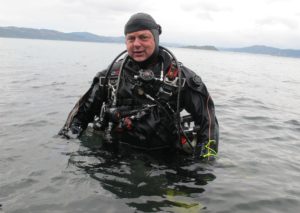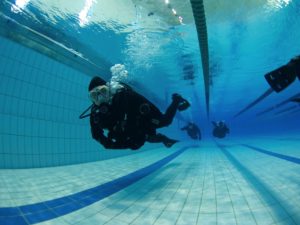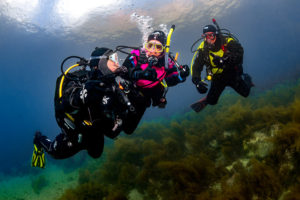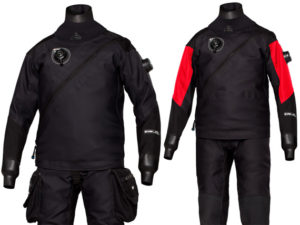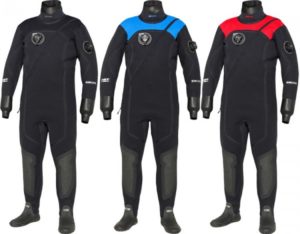Winter is coming and if you want to keep blowing bubbles you need to protect yourself from the cold. As you learnt in your Open Water Diver Course water conducts heat away from the body at least 20 times faster than in air. So when diving in cold water we want to use the correct exposure suit in to be comfortable.
A dry suit does exactly this – it keeps cold water out and by using a layer of air around the body it also keeps us warm especially during those windy surface intervals.
You do need training when diving in a Dry suit. They are another piece of equipment to think about whilst diving and you must learn how to use them correctly in order to have a safe and fun dive. They can be used for buoyancy control and usually require more weight to be added as they can be more buoyant than a wetsuit.
Your dry suit creates an additional air space around you, which affects your buoyancy. As you descend the remaining air in your BCD and dry suit gets compressed by the surrounding water pressure. This means that after a slow start you will suddenly descend a lot faster than you are used to. You will need to inflate the dry suit a little to avoid an uncomfortable suit squeeze and for additional warmth. While you ascend the air in your BCD and dry suit expands due to the decreasing surrounding pressure. This is the reason why a nice slow controlled ascent may turn easily into a rapid ascent while diving in a dry suit. This can easily be avoided by releasing air from your BCD and from your dry suit through the exhaust valve on your left arm.
This may be easier said than done as you must have the air outlet valve of your dry suit at the highest point of your body when releasing air. A classic (but rare) dry suit diving hazard is air getting into your feet and turning you upside down. This can make it difficult to release air from your dry suit and you could end up in a rapid ascent – feet first.
The PADI Dry Suit Specialty Course takes these safety issues into consideration and you will complete a dry suit orientation dive the pool before heading to the sea for two dives in your suit.
Dry suits are expensive pieces of equipment and there are many different options with regard to materials, valves, boots and seals to consider before investing in your own. A lot of it will come down to personal preferences and the types of diving you enjoy. We suggest coming in and looking at the different options and talking with our staff (who are all in dry suits BTW!)
There are some fantastic winter dives around Wellington and by learning some new skills you will open up local diving all year round.
